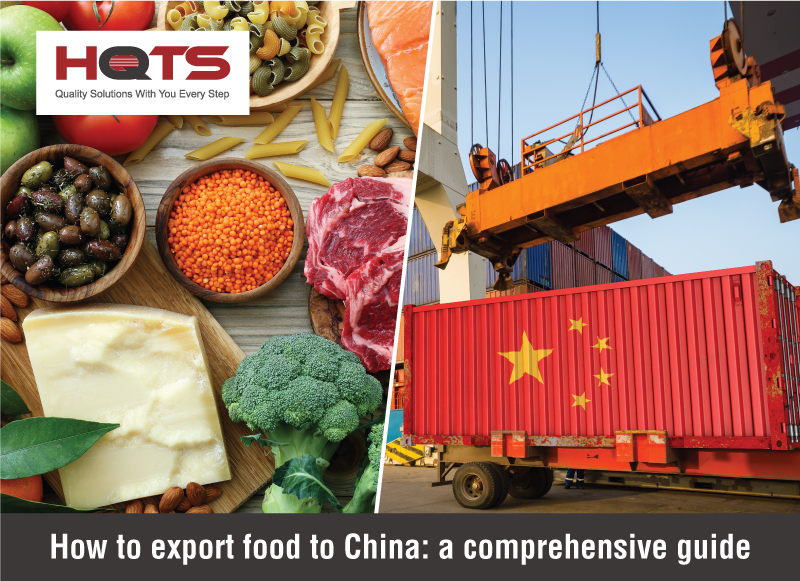China is at the forefront in the global importation of food products, with new opportunities for foreign food-based exporters to join the market. However, there are several barriers to entry such as strict guidelines and regulations that must be given due diligence. Without following these steps, Imported products will be destroyed before entry into the country. Therefore, several steps and processes must be followed to achieve access.
This article will guide you through:
- China’s food importation growth in categories.
- A step-by-step guide on the processes and documentation required to export to China.
China’s leading food importation
China’s economy has grown dramatically in recent years. It has seen a positive growth of 2.4% during 2020. Within this, imports have increased 23.4% from previous years, with 90.8 billion USD worth of food products imported during 2019 from 180 countries (COFCO).

As seen above, New Zealand is the most prominent exporter of food goods to China with 8.18 billion USD. Australia and Thailand are in second and third with 7.73 and 5.98 billion respectively. In terms of year to year growth Brazil saw the highest with 44.01% growth from previous years. With Thailand and New Zealand having an increase of 38.22% and 27.02%. This growth is projected to increase in the future steadily.
Due to this, China has become a lucrative opportunity for international exporters to direct resources to join the market and ride this growth to receive potential high returns.
What products are imported?

In 2019, meat-based, aquatic, and dairy products ranked as the three highest food-based imports. Meat-based products being the highest, accumulating 18.89 billion USD. Spiced condiments, Nuts and Meat products were the fastest in yearly growth, with a growth rate of 98, 92.4 and 70.2%, respectively.
This rapid expansion of food importation shows a vital pulling point for foreign food exporters to join the market. However, precise protocols and paperwork must be followed and completed. This is a careful and methodical process that (with the help of this article) will allow your business to venture into the market.
Step: 1 Choosing your import strategy:
The initial step for an organisation to begin exporting food products to China is deciding which channel is best to do so.
The two most common channels include:
A. Cross Border E-commerce (CBEC)
CBEC is the process of directly shipping products to consumers via an E-commerce platform. Although there still are regulations, tax and duties, there are fewer pre-market approval and border clearance requirements than the general trade channel.
This is a good option for organisations wishing to gain scope to the demand of their products without having to use traditional distribution networks. However, as CBEC ships directly to consumers, it eliminates the potential to grow export volume by servicing B2B clients.
Note: Foreign companies must be aware of the Chinese E-Commerce Law 2019 (known as the “ECL”), which regulates E-commerce shipping and sale. The details of this can be found here.
Advantages:
- A way to gauge the interest of your products within China before committing to time and resource-heavy applications.
- Less pre-market approval and border clearance than general trade exporting.
- Not dependent on local distributors in China.
Disadvantages:
- Individual packing and shipping of products to consumers. Which can take time and resources.
- Less opportunity to grow export volume through servicing B2B clients.
B. General trade exports
General trade exporting is the traditional way to export products to China. This involves incorporating a Chinese importer, distributor, or agent to allow goods to clear customs and quarantine if required. This channel allows for large scale shipment of food products to China, which can lower shipping and clearance costs by applying the economics of scale.
Advantages:
- Able to work with distributors and local organisations to grow the scale of your business.
- Expand business in future servicing B2B clients within China.
- Large scale shipment of products without individual packing.
Disadvantages:
- Additional time and resources needed to enter the market.
- Additional paperwork and regulations to complete.
- Need to find a distributor, importer or agent to clear customs.
Step 2: Registration and Paperwork
Register with the System of Imported Food and Cosmetic Importers and Exporters
Once a channel for exporting products has been chosen. An organisation must register their business through the system of imported food and cosmetic importers and exporters. This can be done either through the China customs website or the Customs + internet website, dependent on the channel.
Once approved, a registration number will be received, which must be kept on record. If there is any information regarding product changes, they will need to be updated in conjunction with the registration number.
CBEC: China Online+Customs.
General Trade: China customs.
If you decide to collaborate with local importers, it is essential to note that they must be registered with the Ministry of Commerce (MOFCOM). Organisations can view local importers past performances through a public register available here. This can help with making the best decision regarding whom to collaborate with. The higher the rating (from AA to D), the less intense the importer’s shipments will be inspected.
Note: some foods have heightened restrictions, such as meat, seafood, feed and dairy. These are subject to further conditions, paperwork and inspection. More information regarding this is available on the AQISQ website found here. Exporters must register each of these shipments with AQISQ’s online service for tracking.
Assemble required paperwork
Once registration has been completed, correct documentation is required before the import of goods proceeds. China has strict protocols and paperwork that must be prepared and presented. This has to be done before products are sent. It is important that all paperwork is correct and in order to stop any extra costs, fines or delays through customs.
Depending on the classification of food product, the documentation that the exporter must provide is:
- Commercial invoice
- A detailed list of packaging
- Bill of Lading
- Export certification of the country of origin
- Hygiene certification
- Certificate of free sale
- Sample of the original label
- Sample of the Chinese label
- Certificate of inspection
Note: First-time exporters will be subject to a more intense review by the GACC (General Administration of Customs of the People’s Republic of China), which may require more paperwork. Once approved, it will be a more straightforward process.
Pre-import licensing
Most products do not require a pre-import license to enter china. However, several product categories such as poultry or dairy products and goods subject to import tariffs such as rice and wheat do. These specific products can be found in the 2021 Goods Catalogue for Automatic Import License Management issued by the AQSIQ.
Note: Foods regulated to have import tariffs must receive a TRQ (Agricultural Products Import Tariff Quotas Certificate) licence.
Step 3: Trademarking & labelling
Registering trademark in China
China operates a separate trademarking entity within its borders. Organisations need to register their business quickly, as China uses a first to file system. Not following this could cause a race to trademark against counterfeit organisations.
To register your trademark, an application must be made to “China Patent & Trademark Office (CTMO)” here.
Labelling
There are specific regulations and labelling requirements that must be adhered to in China. Following the Food safety law 2015, all labels must be written in simplified Chinese and added to the goods before shipping. They include:
- Name, specification and content of goods
- Date of production
- Shelf life
- Storage requirements
- Packer/distributor (name and address)
- Batch number
- Country of origin
- Production license number
- Usage instructions
Note: all labels will need to be approved by the Chinese Inspection and Quarantine Service (CIQS)
Step 4: Food inspection and customs clearance.
For good to clear customs, it must be inspected and approved by the CIQS which governs import regulations. They will undergo the supervision inspection and quarantine of shipments to see if they conform with regulation and all mandatory paperwork is in order.
They will inspect:
- The labelling of your products
- Packaging
- Making a visual check that your products are the same as stated before
- Information related to the product itself, such as product names, brand numbers/models, where the products have been produced
- All details fit in with the national standard.
Once the certificate of goods is achieved, CIQS will stamp the goods as approved. They may enter China to be sent to a distributor.
Note: Goods that fail inspection checks will either be sent back to the exporter and reevaluated once the paperwork has been corrected. If the goods are not sent back, they will be destroyed. Therefore all regulations and paperwork requirements must be followed correctly.
Conclusion
In conclusion, China has become a valuable and ever-growing market for foreign food exporters. However, exporting can be a confusing and challenging process due to the strict regulations within China.
With the help of this article, the process may become easier to navigate China’s import system. Enabling the growth of a new channel for your business activities.





